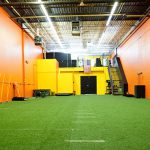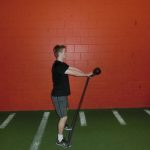In-season training, an often overlooked part of a year-round performance training program.
In-season training plays a major role in an efficient year-round performance training program. One of the major beliefs I have is that you can still improve performance (speed, power, agility on the field) throughout the season not just maintaining it. With that said, it does take some additional analysis on the coach’s part to prescribe the correct training volume, intensity, and methods for each individual athlete. Monitoring fatigue levels, analyzing movement patterns/positions, and incorporating recovery methods are a few things we look at for your in-season program design.
Monitoring/measuring the athlete’s fatigue level is crucial for an in-season program. This is going to tell you as the coach how much work you can do with the athlete. There are several ways that you can do this, but the method that we use is by measuring their Reactive Strength Index (RSI). To do this we take their average height over 4 continuous jumps and divide it by the average ground contact time that they had for those 4 jumps. If the number drops drastically it is a sign that the athlete is fatigued. The goal should be to have their RSI climb throughout the season even if just slightly.
When athletes are in-season often they will develop overuse patterns in their movement. Thus, it is important for the coach to analysis and correct any changes in an athlete’s movement pattern throughout the season. This will help keep performance levels high, but maybe even more importantly help reduces the risk of overuse injuries. For example, in hockey, the hockey skating stride requires a lot of lateral push coming from the glute medius. Due to this I often see the glute medius become overly tight which doesn’t allow it to absorb as much force for stability through the hips. This loss of stability could lead to a loss of power in the stride due to the knee diving in more and possible injuries in the knee, back or groin. If you see a loss of stability through the hips then you know you need to add exercises to regain it for improved performance and injury prevention.
The sport season puts a lot more stress on an athlete not just physically with daily practices or games, but also mentally with less time for school work, friends, etc. For this reason as coaches, we need to help our athletes incorporate things that will help reduce those stressors. We need to do things at the facility (use of myofascial release to break up muscle tissue) as well as guide our athletes in doing things on their own, making sure they have enough sleep and proper nutrition. All this together will do an incredible amount to make sure they are performing at their best during, games, practice, and training.
In-season training is often an overlooked part of a year-round performance training program by many athletes. It is vital that the performance coach and athlete work together in order to maximize their potential for success during the season. An effective program will help ensure that the athlete is performing at their best at the end of the season, as well as help with injury prevention. However, to achieve this takes responsibility by both the coach and athlete working together.





